Plants
of Point Hope Alaska

A guide to flowering
plants
near the village of Point Hope
By the Class of 2003
compiled in 1996-97

Our Plant Study
In the fall of 1996, with the help of a grant from ARCUS, our
class, the class of 2003 began a study of the plants of Point Hope.
We wanted to learn the names of the plants we saw flowering near our
school. We also wanted to learn more about the plants that people in
Point Hope traditionally used for food and medicine.
We learned that the tundra is not all the same. Some places are
wet, and some are dry. Some are exposed to the wind and some are
protected. Some have rocky soils, and some have peat soils. Some
places get sprayed by salt water from the sea, and some areas don't.
We noticed that certain plants liked certain conditions. We could
predict where we could find a plant like cotton grass, or moss
campion for example.
We went to different areas and | collected plants we found there.
We I brought the plants back to our classroom and used plant guides
to find out their names. Then we wrote descriptions of the plants
using special "plant words" we'd learned about, like palmate, which
means shaped sort of like your hand. We all typed our plant
descriptions into the computer using Microsoft Works.

Elder Alice Webber sharing her plant knowledge with
us.
We pressed our plants in a plant press. When they were dry, we
took them out and mounted them on special paper and put a lable on
the them telling the plant's name, where we'd found them, and what
family the plant belonged to.
We invited some Elders to come to our class and look at our dried
plants so they could help us learn the Inupiat names and how the
plants are used.

The North Beach in bloom in August.
We made cookies and tea to serve the Elders, and as they talked,
we took turns writing down what they told us. After they left, we
added their information to our plant descriptions.
The high school biology classes were studying microhabitats, and
they took pictures of the plants for us. We also borrowed some
photographs from the Inupiat History and Culture office in Barrow.
Karen Brewster and Jana Harcharek took those pictures, and we thank
them for loaning them to us for this took those photos, and we thank
them.
Jessie Downey, a teacher's aide in our school, took the pictures
of the Elders visiting our classroom.

Elders Kirk Oviok and Jacob Lane share their
knowledge about plants with our class.
We hope you enjoy our book, Plants of Point Hope, and help us to
keep learning by sending us information that we may have left
out.
|
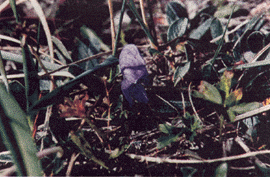
photo by Baldassare
Mineo
Technical name: Aconitum
delphinifolium
Inupiat name: ?
Common name: Monkshood
Family: Buttercup
This plant likes damp areas. It has a rather
large purplish flower. The leaves are lobed and low
to the ground. This plant has poisonous parts.
USES: None. Caution. This plant is poisonous
After handling monkshood you should wash your hands
before eating or putting your fingers in your
mouth.
|
|
|

photo by Baldassare
Mineo
Technical name: Dodecatheon
frigidum
Inupiat name: ?
Common name: Frigid Shooting Stars
Family: Primrose
This plant likes protected areas. We found them
growing down in ravines, out of the wind on south
facing slopes where the ground was damp. They have
bright purple flowers with white near the stamens.
heads turned upside down. Their leaves are basal
and roundish.
USES: None.
|
|
|

Photo by Baldassare Mineo
Technical name: Senecio pseudo-Arnica
Inupiat name:
Common name:
Family: Composite
The plant is found in sandy soils in or near the salt
spray zone. The leaves are large and leathery. The flower is
a bright yellow color and shaped like a daisy.
USES: None that we learned of.
|
|

Photo by Baldassare
Mineo
Technical name: Papaver lapponicum
.
Inupiaq name:
Common name: Arctic poppy.
Family: Poppy
We found Arctic poppies in rocky areas that
weren't too wet. The leaf is a basal and pinnate.
The flower has five pedals, and is yellow. It is
about 8 to 10 inches tall. The stem is furry, and
so are the leaves.
The poppy flower always faces the sun so it can
stay warm. To do this, the stem grows unevenly. The
side away from the sun grows faster, tipping the
flower toward the sun.
USES: None that we learned of.
|
|
|

Photo by Baldassare
Mineo
Technical name: Androsace chamaejasme
Inupiat name: ?
Common name: Rock Jasmine
Family: Primrose
This plant is found on rocky tundra. The leaves
are lanceolate and basal the flower has pale yellow
petals and dark yellow centers. it has 5 white
petals.
USES: None that we know of.
|
|
|

Photo by Baldassare
Mineo
Technical name: Saxifraga bronchialis
Inupiat name: ?
Common name: Yellow Spotted Saxifrage
Family: Saxifrage
This plant is found in rocky tundra. The leaves are
small and pointy with hairse on the edges. The flowers
are really beautiful. They are light yellow with dark
yellow spots on them
USES: None that we know of.
|
|

Photo by Baldassare
Mineo
Technical name: Saxifraga hirculus
Inupiat name: ?
Common name: Bog Saxifrage
Family: Saxifrage
This plant is found on wet tundra and in bogs.
The leaves are small and narrow and go up the stem
in an alternate pattern. The flower is dark
yellow.
USES: None that we know of.
|
|
|

Photo by Baldassare
Mineo
Technical name: Saxifraga
eschscholtzii
Inupiat name: ?
Common name: Cushion Saxifrage
Family: Saxifrage
This plant is found in rocky tundra. The leaves
are small greyish-green and hairy. The flowers are
smallish with yellow petals.
USES: None that we know of.
|
|
|

Photo by Jana Harcharek
Technical name: Artemisia tilessii
Inupiat name: saraigruaq
Common name: Tall Wormwood
Family: Aster
Found in sandy, but not salty areas like along the shore
of the lagoon. The leaves are palmate and alternate. The
flowers are small, yellow and clustered on the top of the
top of the plant.
USES: This is a very useful medicinal plant. The leaves
are gathered when the plants are fully leafed out. Don't
keep the leaves in a damp place or they will mold. Dry them
and then store them in a cloth bag, not plastic. They can be
used for sore throats and coughs or colds. Chew the leaves
and swallow the juice, but spit the leaves out.
Some people make a tea out of the leaves and drink a half a
cup in the morning and a half a cup at night when they are
sick.
The leaves can be used for cuts too. Lay the leaves over the
cut and wrap a bandage around it. The wormwood will keep out
infection. For toothaches, pack some leaves around the tooth
that is hurting.
Some people use the leaves for aching joints like knees.
Wrap the leaves over the aching or swollen joint, and hold
in place with a cloth. Leave the leaves on for three days,
then the joint will feel better.
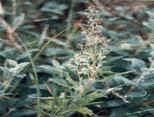
|
|
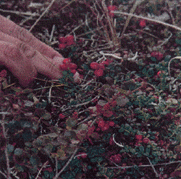
Photo by Jana
Harcharek
Technical name: Vaccinium vitis-idaea
Inupiat name: Kikminnaq
Common name: Low-bush Cranberry
Family: Heath/Ericaceae
This plant is found on wet tundra and in bogs.
It has pink bell-shaped flowers, and later bright
red berries. The small oval leaves are thick and
shiny. The plant grows real low to the ground.
USES: The berries are picked mixed with sugar
and eaten fresh. They can also be stored in a cloth
bag hung up in an ice celler. They freeze and stay
nice and fresh. The cranberry juice can be used to
clean out your system or if someone has a urinary
infection.
|
|
|

Photo by Baldassare
Mineo
Technical name: Pedicularis sudetica
Inupiat name; Qutliiraq (wooly lousewort?)
Common name: Fern Leaf Lousewort
Family: Figwort
Found in wet areas, this plant has dark rose
colored flowers. Like the common name says, it has
leaves that look like ferns and are at the base of
the plant.
USES: The Inupiat name qutliiraq seems to apply
to all the louseworts, which makes sense since all
the louseworts can be eaten. Flowers can be picked
and fermented in water then eaten with oil and
sugar. the roots can be eaten fried, boiled or raw.
Be careful eating the roots because they can make
you sleepy.
|
|
|

Photo by Baldassare Mineo
Technical name: Armeria maritima
Inupiat name:
Common name: Thrift
Family: Leadwort
This small plant is common along the beach areas. The
flower is a round ball of pink that is several inches higher
than the leaves. The leaves are long and thin and kind of
greyish-green. The leaves are basal.
USES: None that we learned of.
|
|

Photo by Baldassare
Mineo
Technical name: Polygonum bistorta
Inupiat name: Ippik
Common name: Pink Plumes
Family: Buckwheat
This plant is found in wet tundra. We found some
in low areas between the airport and town. The
leaves are lanceolate. The flowers are pink. the
head of the flower is big and fluffy with lots of
petals. The height of the plant is about 8
inches.
USES: The leaves are gathered and cooked with
flour and sugar during the spring and summer. The
leaves can be stored in a barrel with seal oil. The
leaves can also be eaten raw.
|
|
|

Photo by Karen
Brewster
Technical name: Oxyria digynia
Inupiat name: Qunullig
Common name: Mountain Sorrel
Family: Buckwheat
The plant is found by the lagoon on east side
which is wet peat soils. The leaves are basal and
heart shape. The color of the flower stalk is pink.
It is about 7 to 8 inches tall.
USES: The leaves are gathered and cooked with
sugar since they are sour. The can be stored after
they are cooked in zip lock bags or jars.
|
|

Photo by Jana Harcharek
Technical name: Rumex arcticus
Inupiat name: quagaq
Common name: Sour Dock
Family: Buckwheat
This plant is found in damp places. The leaves are oval
shaped. The floweres are on spikes, and not very big. The
plant grows tall-10 or more inches. In the fall the whole
plant turns red as in this picture.
USES: This plant is gathered while the leaves are green.
The leaves are cooked with a little water and sugar. It
tastes a little like spinach.
|
|
photo s by Jana Harckeck
Technical name: Hedysarum alpinum
Inupiat name: Masu
Common name: Eskimo Potato
Family: Pea
This plant grows in gravelly, but kind of wet areas. It
is pretty big - about 12 inches or more with lots of
leaflets on branches off the stem. The flowers are purple
and there are a lot of them on lined up on the top of the
stem.
USES: The long root is dug up in the fall or spring and
eaten either raw or boiled. It can be stored buried in the
sand or in a barrel covered with dirt. This keeps them from
drying out, and keeps the mice out of them.
|
|
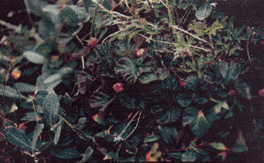
Photo by JBaldassare Mineo
Technical name: Rubus chamaemorus
Inupiat name: Aqpik
Common name: Cloudberry
Family name: Rose
This plant is found on wet tundra. The leaves are simple
and palmate, and the edges are jagged. The flower has five
white petals. The plant has a berry that is light orange
when they are ripe. The berry looks like a clump of salmon
eggs.
USES: Pick the berries and eat them fresh!! They are
good. They can also be stored in oil.
|
|

Photo by Baldassare Mineo
Technical name: Erigeron humilis
Inupiat name:
Common name: Mountain Fleabane
Family: Aster
Found in moist places. The flower is a daisy like flower
that can be purplish to white. There aren't many leaves-one
or two, and the leaves are long and hairy.
USES: None that we know of.
|
|

Photo by Baldassare
Mineo
Technical name: Anemone narcissisflora
Inupiat name: ?
Common name: Narcissus-flowered anemone
Family: Anemone
This plant is found in wet tundra, like by the
snowfence. The leaves are palmate. The plant is
about 8 to 14 inches tall and the leaves are hairy
and have 3 to 5 lobes. The flower has white petals
and yellow middles. The petals completely surround
the stem.
USES: None that we know of.
|
|
|

Photo by Jana
Harcharek
Technical name: Petasites frigidus
Inupiat name: Mapkuttitaagruaq
Common name: frigid coltsfoot
Family: Composite
This plant is found in damp areas of the tundra.
The large, dark green leaves are simple and the
arrangement is alternate. The shapes are wedge
shaped with wavy edges. There are many flowers one
stem. The stems are tall, 12 inches to 18 inches
high. The flowers are white to pinkish.
USES: Coltsfoot has not been used in Point Hope,
though the leaves are edible. Some people use the
large leaves to cover barrels of food. We learned
from the Inupiat History and Culture people that
coltsfoot has been used in other villages on the N.
Slope for treatment of arthritis.
|
|
|

Photo by Karen Brewster
Technical name: Empetrum nigrum
Inupiat name: Asiaq
Common name: Crowberry, in Point Hope, its called
Blackberry.
Family: Crowberry
This plant is found on the tundra. Its leaves are
opposite on woody branches. They look like needles on a
Christmas tree. In the fall the plants have a small dark,
almost black, round berries.
USES: Mostly people in Point Hope gather the berries and
eat them fresh. The berries are also used in pies, and some
people mix the berries with fish livers to make dish called
tingook.
|
|
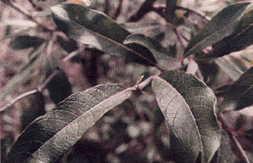
Photo by Jana
Harcharek
Technical name: Salix alexensis
Inupiat name: Uqpik
Common name: Big Willow or River Willow
Family: Salix
Grows along rivers and creeks. This is a shrubby
kind of willow that grows up more than along the
ground like most Arctic willows. Its leaves are
long and narrow.
USES: The willow has lots of uses. The new green
leaves are picked in the spring, and eaten in
several ways. They can be cooked, or stored raw in
seal oil, and then the seal oil is used in the
regular way (like a condiment) with meat. When
leaves are stored they are called "sura". The
leaves can be fermented in a [text
missing].
|
|
|

Photo by Jana
Harcharek
Technical name: Salix reticulata
Inupiat name: ?
Common name: Netted Willow
Family: Willow
The plant grows flat to the ground. Its leaves
are almost round with lines on them that look like
netting. We found it in dry, rocky areas of the
tundra, though we read that it also grows in wet
areas.
USES: This willow does not seemed to have been
used as a food.
|
|
View narrative on this project.
Go to ARCUS' main page








